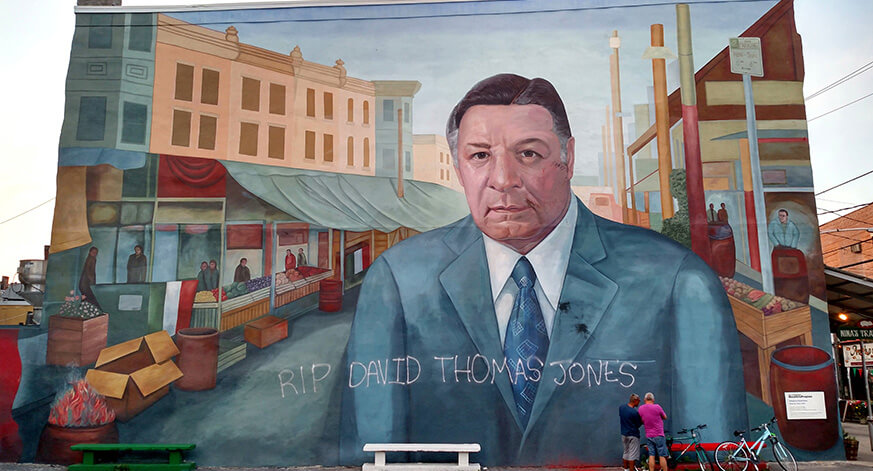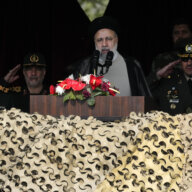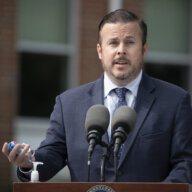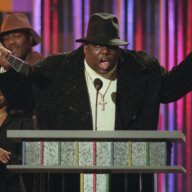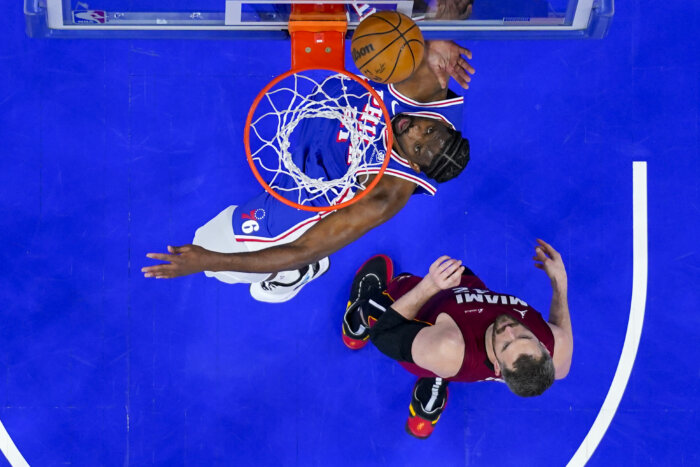Memory is not history. History is not pretty.
Think of that when considering the conundrum of Frank Rizzo, and the public art created in his name. Longtime police officer Rizzo (1920-1991) served as Philadelphia police commissioner from 1968 to 1971 and as Mayor from 1972 to 1980. He was known for a tough, law-and-order stance when this city was a lawless, un-safe cesspool, as well as being Philly’s first Italian-American Mayor. Rizzo was also known, notoriously, for his often head-busting police tactics and unconscionable commentary toward Blacks and homosexuals.
To some, he’s a saint. To others, he’s a racist. That mixed legacy was called into question when the removal of a statue memorializing Confederate Gen. Robert E. Lee in Charlottesville, VA turned deadly, and in its wake, placed a deservedly uglier light on racism. With that came questions of local public art dedicated to Rizzo: the immense Rizzo Mural Arts wall in the Italian Market, the towering Rizzo statue in Thomas Paine Plaza yards from City Hall; a totem that, on August 16, got egged, with its yolk remaining during that night’s “Philly in Charlottesville” rally.
Philadelphia Councilwoman Helen Gym – who came to the area from Columbus, OH, in 1986 – wants the Rizzo statue taken down, or, at least gone from a public space so close to the seat of Philly government. As soon as City Council returns to session in September, she’ll initiate a public process to have sculptor Zenos Frudakis’ 10-foot-tall bronze Rizzo sculpture at the Municipal Services Building Plaza relocated.
“The call to remove the Rizzo statue from the Plaza is not a new one, and has been going on for some time,” said Gym, without referring specifically to such calls and petitions from Black Lives Matter and the Coalition for Real Justice activists. “I don’t think, though, there is any question that now is the time to take action. We’re seeing that across the country. It’s not just Charlottesville. Baltimore removed its Confederate statues – decided on Monday, removed them on Wednesday. We need to decide to stop talking and take action.”
Gym is not trying to play a game of “oppressive Olympics” when it comes to what or who is more racist than Robert E. Lee. “Frank Rizzo was an unabashed racist,” said the Councilwoman.
“Would he have called himself a racist? I think he’s a complicated man, a lot of different things to a lot of different people, one of which just happens to be an embodiment of racist practices that still exist in our city today,” and that we still struggle to overcome. What doubly irks Gym is that the towering Rizzo statue looms large in the center of our city, in a spot almost as prominent as Billy Penn. That’s not the place for Rizzo in her mind. He belongs in a museum as part of Philadelphia history. “I’m not out to destroy his history or erase his memory,” said Gym. “Part of this debate is reminding people of what his history was – not that it was controversial or had many sides – but that he was a racist.” And with that, Rizzo – the statue – has become a target for detractors such as those who egged his statue on Wednesday morning, a prank that on Wednesday night, and during the “Philly in Charlottesville” rally, remained prominent.
The Mural Arts’ Rizzo portrait in the Italian Market, painted in 1995 by Diane Keller, has seen its share of defacing, up-to-and-including its most recent graffiti-ing in June 2017. Such controversy has been par for the course with as the mural has been “both beloved and reviled,” said Mural Arts’ Executive Director Jane Golden in a prepared statement. “Given our history about community-driven projects, perhaps it is time to have a conversation about whether this mural should stay or be replaced by something else.”
Like City Council, Mural Arts will embark on a project (Monument Lab) that questions what works as a monument in present-day Philadelphia, one which, in Gym’s mind, seeks to “more trans-friendly, more LGBTQ friendly and sense messages of inclusivity.” Painter Keller adds that is up to the South Philly community to decide if the mural is still relevant. “I am open to a conversation about it being replaced with something that may be more representative of the neighborhood today.”
On the morning after the egging, the Rizzo stronghold of the Italian Market is abuzz with conversation in gathering places such as Center City Pretzel Co. and Gordano’s Produce, both on Washington Avenue. For most habitués out-and-about at 6 a.m., the discussion is of neighborhood pride and keeping all monuments intact. One neighborhood alumnus, “Capt.” Jesse Giordano had an interestingly pragmatic viewpoint. “There’s always been love for Rizzo here because of the whole Italian thing,” he said. “That hasn’t changed, but lots of things do. This neighborhood isn’t 95% Italian as it once was, but rather a melting pot. Not everyone is comfortable with the statue or the mural. Maybe it’s better to have some peace in town, maybe better to have less tension and more peace than status or murals.”



